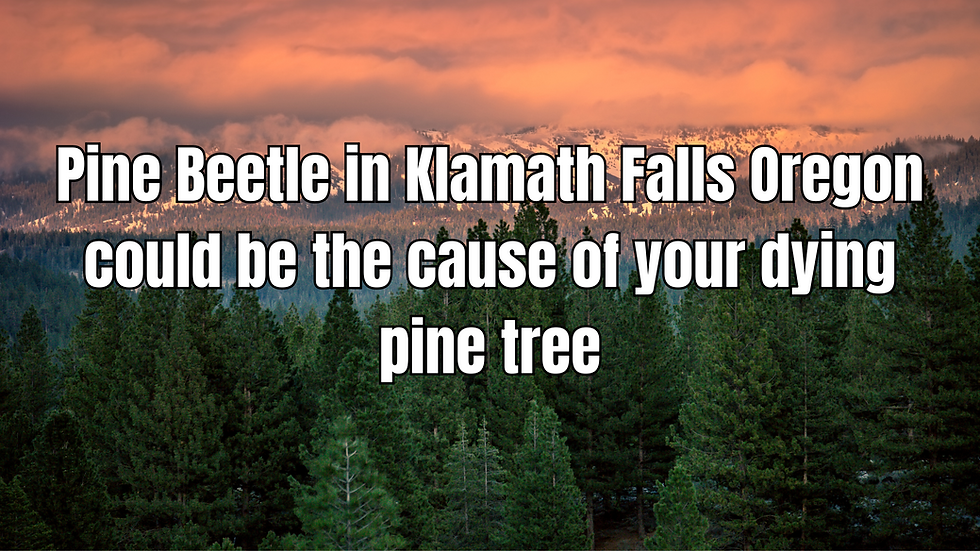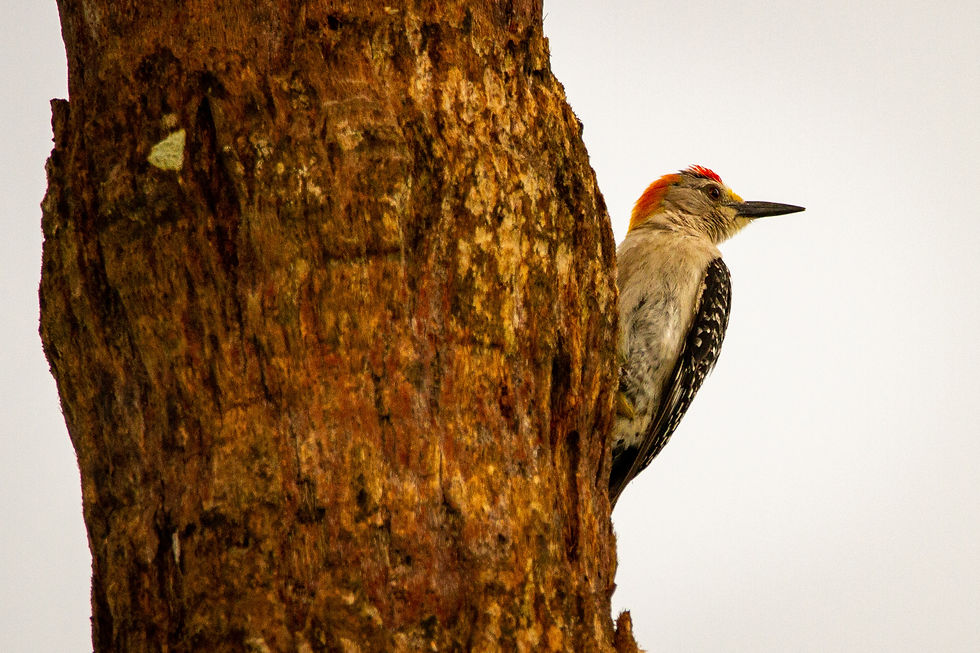Pine Beetle in Klamath Falls Oregon could be the cause of your dying pine tree
- basintreecare
- Jul 14, 2023
- 7 min read
Updated: Jul 20, 2023

Pine beetle infestations in Klamath Falls are a significant concern for forest ecosystems and tree owners alike. These tiny but destructive insects can wreak havoc on pine trees, causing widespread damage and tree mortality. Understanding the nature of pine beetle infestations is crucial for effective management and preservation of our valuable pine forests. In this blog, we will delve into the background of pine beetles, explore their life cycle, discuss how to identify signs of infestation, and provide recommended treatment options, including the importance of tree removals. By gaining insight into pine beetle infestations, we can take proactive measures to protect our trees and mitigate the devastating effects of these voracious pests.
Background on Pine Beetles
Pine beetles are a group of insects belonging to the Scolytinae subfamily, with several species known for their destructive impact on pine trees. These small beetles typically target weakened or stressed trees, burrowing into the inner bark to lay their eggs. As their larvae develop, they feed on the tree's nutrients, disrupting its vascular system and ultimately leading to its decline and death. Pine beetles are native to many forest ecosystems, playing a crucial role in the natural cycle of forest health by attacking and decomposing unhealthy trees. However, under certain conditions, such as prolonged drought, overcrowding, or poor forest management practices, pine beetle populations can surge, resulting in widespread infestations that devastate entire stands of pine trees. Understanding pine beetles is essential for implementing effective management strategies to protect our forests and mitigate their impact on tree health.

The Pine Beetle Life Cycle
The life cycle of the pine beetle consists of four distinct stages: egg, larva, pupa, and adult. It begins when adult female beetles bore into the inner bark of pine trees to lay their eggs. These eggs hatch into larvae, which feed on the tree's phloem and outer sapwood. As the larvae develop, they create winding tunnels called galleries within the tree, causing damage to the vascular system. The larvae eventually transform into pupae within these galleries, undergoing a metamorphosis phase. After a period of development, adult beetles emerge from the pupae and exit the tree through small exit holes. The adult beetles then seek out new host trees to continue the cycle. The life cycle of the pine beetle is influenced by environmental factors such as temperature, moisture, and availability of suitable host trees. Understanding this life cycle is crucial for implementing timely control measures and mitigating the spread of infestations.
For more information on the Mountain Pine Beetle you can download the Fact sheet from the Oregon Department of Forestry below. https://www.oregon.gov/odf/Documents/forestbenefits/MountainPineBeetle.pdf
Factors contributing to pine beetle outbreaks
Pine beetle outbreaks in Klamath Falls can be influenced by various factors that contribute to their population growth and the severity of infestations. One of the primary factors is the health and vigor of the host trees. Weakened or stressed trees, due to factors such as drought, age, or other pest damage, are more susceptible to beetle attacks. Climate conditions also play a significant role, as warm temperatures and prolonged drought periods can favor beetle reproduction and survival. Forest management practices, including the density and composition of pine stands, can impact the vulnerability of trees to beetle infestations. Additionally, the presence of suitable breeding sites and the connectivity of infested areas can contribute to the rapid spread of pine beetles. Understanding these contributing factors is essential for implementing effective prevention and management strategies to mitigate the impact of pine beetle outbreaks on our forests and tree populations.
Identifying Signs of Pine Beetle Infestation
Identifying signs of pine beetle infestation in Klamath Falls is crucial for early detection and prompt management of these destructive pests. By recognizing the telltale symptoms, tree owners can take immediate action to minimize the impact on pine trees and prevent further spread. Common signs of a pine beetle infestation in Klamath Falls include the presence of boring dust or frass, fading or discoloration of foliage, resinous pitch tubes on the trunk, and woodpecker activity. These indicators provide valuable insights into the health of the tree and the extent of the infestation. In this section, we will explore these signs in detail, empowering you with the knowledge to identify and address pine beetle infestations effectively. By staying vigilant and proactive, we can protect our pine trees and preserve the beauty and integrity of our forests.
Signs of Pine Beetle Infestation:

1. Boring Dust or Frass
Bark and trunk signs play a crucial role in identifying a pine beetle infestation. One of the most prominent signs is the presence of boring dust or frass, which resembles fine sawdust, accumulating in bark crevices, branch junctions, or near the base of the tree. This is the result of adult beetles tunneling into the inner bark to lay their eggs and the subsequent activity of the larvae.
2. Resinous Pitch Tubes
Another key indicator is the presence of resinous pitch tubes on the trunk. These are small, sticky, and often reddish-brown or white mounds of resin that oozes from the tree's defense response to the beetle attack. These pitch tubes serve as entry points for the beetles and can be found scattered across the trunk and branches. In more advanced stages of infestation, the bark may exhibit reddish-brown discoloration or fading, indicating the tree's struggle to defend against the beetle's assault.

3. Woodpecker Activity

Additionally, woodpecker activity can also be an indication of a pine beetle infestation. Woodpeckers feed on the larvae under the bark and leave characteristic holes or patches of missing bark on the trunk as they search for their prey. These bark and trunk signs provide important visual cues for identifying a pine beetle infestation, allowing for timely intervention and management of affected trees.

4. Discoloration and Fading of Foliage
Discoloration and fading of foliage can be a sign of a pine beetle infestation due to the disruption of the tree's vascular system. As pine beetles tunnel and feed on the inner bark, they interrupt the flow of nutrients and water within the tree. This interference can lead to a decline in the tree's health, resulting in the discoloration and fading of foliage. The affected needles may turn yellow, red, or brown, and the discoloration typically starts at the top of the tree and progresses downward over time.
5. Dying Pine Tree
A dying pine tree can be a strong indicator of a severe pine beetle infestation. As the infestation progresses, the beetles disrupt the tree's nutrient transport system and cause significant damage to the inner bark and sapwood. This damage weakens the tree's ability to uptake water and nutrients, leading to overall decline and eventual death. The tree may exhibit visible signs of decay, such as extensive needle browning or shedding, dead branches, and a thinning canopy. If a pine tree shows signs of rapid decline and fails to recover despite adequate care and watering, it is essential to consider the possibility of a pine beetle infestation as a potential cause.

Recommended Treatment Options for Pine Beetle Infestations in Klamath Falls
When it comes to treating pine beetle infestations in Klamath Falls, early intervention is key to mitigating the damage and preserving the health of surrounding pine trees. Several treatment options are available to combat pine beetle infestations and protect valuable tree populations. These treatment approaches aim to disrupt the beetles' life cycle, reduce their population, and prevent further spread. Recommended treatment options include preventative measures to protect healthy trees, early detection and monitoring techniques, and targeted treatments for infested trees.

Preventative measures to protect healthy trees
Taking preventative measures is essential for protecting pine trees and preventing pine beetle infestations in Klamath Falls. One key approach is to maintain the overall health and vigor of the trees. Healthy trees are better equipped to defend against pests, including pine beetles. This can be achieved through proper tree care practices, such as regular watering, appropriate fertilization, and adequate sunlight exposure. Additionally, promptly removing and disposing of any infested or dead trees in the vicinity can limit the spread of pine beetles to healthy trees. By implementing these preventive measures, tree owners can create an environment less favorable for pine beetle infestations and ensure the long-term health and vitality of their pine tree populations.
Early Detection and Monitoring Techniques
Early detection and monitoring techniques are crucial in effectively managing pine beetle infestations in Klamath Falls. Detecting the presence of pine beetles at an early stage allows for prompt action, minimizing the spread and impact of the infestation. Regular monitoring involves inspecting trees for signs of beetle activity, such as boring dust, pitch tubes, or fading foliage. By regularly checking susceptible trees, infestations can be identified before they become severe and widespread. Early detection enables timely treatment and control measures to be implemented, such as the removal of infested trees. Pesticides are generally not recommended because trees are already in decline and treating with pesticides can further decline the tree and lead to death. By staying vigilant and implementing proactive monitoring techniques, tree owners can intervene early, mitigating the damage caused by pine beetle infestations and protecting the health of their pine tree populations.

Treatment methods for infested pine trees in Klamath Falls
When it comes to treating infested trees affected by pine beetles in Klamath Falls, one of the most effective methods is tree removal. Tree removal is recommended in cases where the infestation has spread extensively and the tree's health cannot be salvaged. Removing infested trees is crucial to prevent the beetles from spreading to neighboring healthy trees and reducing the overall population of beetles in the area. Additionally, removing infested trees allows for proper disposal to prevent further infestation. It is important to enlist the help of professional tree removal services to ensure safe and efficient removal, as well as to comply with local regulations. While tree removal can be a difficult decision, it is a necessary step to prevent the infestation from causing further damage and to protect the health of surrounding trees.
Cost to Cut Down Pine Tree
Estimating the cost of a tree removal involves careful consideration of multiple factors that impact the complexity and scale of the project. Our experienced team takes into account various key factors when providing cost estimates. These factors include tree size, location, accessibility, condition, and the complexity of the removal process. Moreover, additional considerations such as nearby structures, power lines, or other obstacles requiring specialized equipment or precautions may influence the overall cost. We understand that each tree removal is unique, which is why we offer free estimates to our clients. If you want to learn more about the cost of removing a pine tree, we invite you to read our informative blog post https://www.basintreecare.com/post/financing-and-the-cost-of-tree-removal or contact us at (541) 851-9080 to schedule a complimentary estimate. We are pleased to provide senior and military discounts, as well as financing options tailored to suit your budget.

Tree removal plays a vital role in controlling the spread of pine beetles in infested trees. When an infestation reaches a severe stage, removing the infested tree becomes necessary to prevent the beetles from spreading to healthy trees and further damaging the surrounding forest ecosystem. By eliminating infested trees, the population of pine beetles is reduced, disrupting their life cycle and limiting their impact on other susceptible trees. Tree removal should be carried out by professional tree service companies, ensuring safe and efficient removal while adhering to local regulations. Taking prompt action and making the difficult decision to remove infested trees is a crucial step in mitigating the damage caused by pine beetles and safeguarding the health of our valuable pine tree populations.





Comments